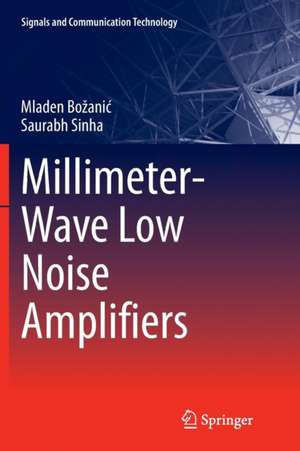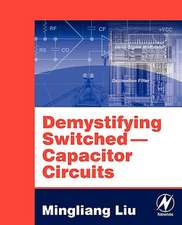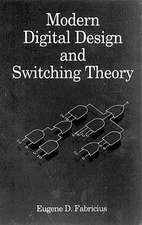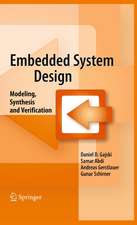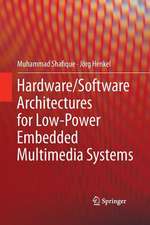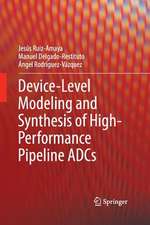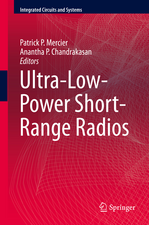Millimeter-Wave Low Noise Amplifiers: Signals and Communication Technology
Autor Mladen Božanić, Saurabh Sinhaen Limba Engleză Paperback – 23 mai 2018
| Toate formatele și edițiile | Preț | Express |
|---|---|---|
| Paperback (1) | 730.02 lei 6-8 săpt. | |
| Springer International Publishing – 23 mai 2018 | 730.02 lei 6-8 săpt. | |
| Hardback (1) | 1007.80 lei 6-8 săpt. | |
| Springer International Publishing – 22 noi 2017 | 1007.80 lei 6-8 săpt. |
Din seria Signals and Communication Technology
- 18%
 Preț: 952.89 lei
Preț: 952.89 lei - 18%
 Preț: 1559.80 lei
Preț: 1559.80 lei - 17%
 Preț: 361.80 lei
Preț: 361.80 lei - 18%
 Preț: 811.61 lei
Preț: 811.61 lei - 15%
 Preț: 585.26 lei
Preț: 585.26 lei - 18%
 Preț: 727.97 lei
Preț: 727.97 lei - 15%
 Preț: 585.90 lei
Preț: 585.90 lei -
 Preț: 393.35 lei
Preț: 393.35 lei - 20%
 Preț: 1002.73 lei
Preț: 1002.73 lei - 15%
 Preț: 641.71 lei
Preț: 641.71 lei - 20%
 Preț: 338.92 lei
Preț: 338.92 lei - 18%
 Preț: 1579.66 lei
Preț: 1579.66 lei - 18%
 Preț: 896.08 lei
Preț: 896.08 lei - 18%
 Preț: 847.11 lei
Preț: 847.11 lei - 18%
 Preț: 1234.77 lei
Preț: 1234.77 lei - 18%
 Preț: 905.54 lei
Preț: 905.54 lei - 15%
 Preț: 646.43 lei
Preț: 646.43 lei - 20%
 Preț: 662.48 lei
Preț: 662.48 lei - 15%
 Preț: 641.20 lei
Preț: 641.20 lei - 18%
 Preț: 1847.84 lei
Preț: 1847.84 lei - 18%
 Preț: 946.24 lei
Preț: 946.24 lei - 18%
 Preț: 1241.10 lei
Preț: 1241.10 lei - 20%
 Preț: 649.43 lei
Preț: 649.43 lei - 20%
 Preț: 993.28 lei
Preț: 993.28 lei - 18%
 Preț: 940.57 lei
Preț: 940.57 lei - 18%
 Preț: 1389.30 lei
Preț: 1389.30 lei - 20%
 Preț: 1003.50 lei
Preț: 1003.50 lei - 18%
 Preț: 953.52 lei
Preț: 953.52 lei - 20%
 Preț: 1001.16 lei
Preț: 1001.16 lei - 18%
 Preț: 1415.36 lei
Preț: 1415.36 lei - 15%
 Preț: 653.33 lei
Preț: 653.33 lei - 15%
 Preț: 645.60 lei
Preț: 645.60 lei - 15%
 Preț: 637.28 lei
Preț: 637.28 lei - 18%
 Preț: 948.79 lei
Preț: 948.79 lei - 18%
 Preț: 945.62 lei
Preț: 945.62 lei - 18%
 Preț: 836.36 lei
Preț: 836.36 lei - 18%
 Preț: 1225.46 lei
Preț: 1225.46 lei - 15%
 Preț: 635.01 lei
Preț: 635.01 lei - 15%
 Preț: 639.25 lei
Preț: 639.25 lei - 15%
 Preț: 646.30 lei
Preț: 646.30 lei - 15%
 Preț: 639.25 lei
Preț: 639.25 lei - 15%
 Preț: 712.36 lei
Preț: 712.36 lei - 20%
 Preț: 1006.12 lei
Preț: 1006.12 lei - 18%
 Preț: 970.56 lei
Preț: 970.56 lei
Preț: 730.02 lei
Preț vechi: 890.27 lei
-18% Nou
Puncte Express: 1095
Preț estimativ în valută:
139.71€ • 145.32$ • 115.34£
139.71€ • 145.32$ • 115.34£
Carte tipărită la comandă
Livrare economică 15-29 aprilie
Preluare comenzi: 021 569.72.76
Specificații
ISBN-13: 9783319887029
ISBN-10: 3319887025
Pagini: 334
Ilustrații: XVIII, 334 p. 264 illus., 46 illus. in color.
Dimensiuni: 155 x 235 mm
Greutate: 0.51 kg
Ediția:Softcover reprint of the original 1st ed. 2018
Editura: Springer International Publishing
Colecția Springer
Seria Signals and Communication Technology
Locul publicării:Cham, Switzerland
ISBN-10: 3319887025
Pagini: 334
Ilustrații: XVIII, 334 p. 264 illus., 46 illus. in color.
Dimensiuni: 155 x 235 mm
Greutate: 0.51 kg
Ediția:Softcover reprint of the original 1st ed. 2018
Editura: Springer International Publishing
Colecția Springer
Seria Signals and Communication Technology
Locul publicării:Cham, Switzerland
Cuprins
Introduction and Research Impact.- Specification-Governed Telecommunication and High-Frequency-Electronics Aspects for Low-Noise Amplifier Research.- Technologies for Low-Noise Amplifiers in the Millimeter-Wave Regime.- Passives for Low-Noise Amplifiers in the Millimeter-Wave Regime.- General Low-Noise Amplifiers.- Broadband Low-Noise Amplifiers.- State-of-the-Art Low Noise Amplifiers in the Millimeter-Wave Regime.- Advanced Low-Noise Amplifier Optimization Topics.- Low-Noise Amplifier Optimization via Electronic Design Automation.- Evaluation of the Hypothesis and Research Questions, Final Remarks and Future Research.
Notă biografică
Saurabh Sinha is full professor of Electronics at the University of Johannesburg, South Africa, where he has been Executive Dean of the Faculty of Engineering and Built Environment since 2013. In addition he is the managing editor of the South African Institute of Electrical Engineers (SAIEE) Africa Research Journal.
Textul de pe ultima copertă
This book examines the challenges of low-noise amplifier (LNA) research and design in the millimeter-wave regime by dissecting the common LNA configurations and typical specifications into parts, which are then optimized separately over several chapters to suggest improvements in the current designs.
Current trends towards increased wireless connectivity and the need to stay connected everywhere and all the time, call for extremely high data rates. Most of the wireless networks operate in frequency bands measured in low gigahertz. Typically, this is done through channels with moderate bandwidth. To keep up with the trends for increased data transmission rates, new and innovative ideas are needed. One of the areas of investigation is the transmission in millimeter-wave regime, ranging from 30 GHz to 300 GHz, where there is an abundance of bandwidth. The low-noise amplifier (LNA) is the first component that appears in the front ends of most microwave and millimeter-wavereceivers after an antenna. The performance of a millimeter-wave receiver is therefore largely dependent on the performance of the LNA that is used. Primarily, the LNA is tasked with amplifying a signal while introducing as little noise into the signal as possible. This is a necessity, because the signal received by the antenna is already submerged in noise, thus the signal, before it can be processed, needs to be amplified with the smallest possible amount of additional noise introduced in this process. This is even more so true, due to the limitation of the wave propagation in millimeter-wave regime, where there is a trade-off between data-rate, range and power.
Current trends towards increased wireless connectivity and the need to stay connected everywhere and all the time, call for extremely high data rates. Most of the wireless networks operate in frequency bands measured in low gigahertz. Typically, this is done through channels with moderate bandwidth. To keep up with the trends for increased data transmission rates, new and innovative ideas are needed. One of the areas of investigation is the transmission in millimeter-wave regime, ranging from 30 GHz to 300 GHz, where there is an abundance of bandwidth. The low-noise amplifier (LNA) is the first component that appears in the front ends of most microwave and millimeter-wavereceivers after an antenna. The performance of a millimeter-wave receiver is therefore largely dependent on the performance of the LNA that is used. Primarily, the LNA is tasked with amplifying a signal while introducing as little noise into the signal as possible. This is a necessity, because the signal received by the antenna is already submerged in noise, thus the signal, before it can be processed, needs to be amplified with the smallest possible amount of additional noise introduced in this process. This is even more so true, due to the limitation of the wave propagation in millimeter-wave regime, where there is a trade-off between data-rate, range and power.
Caracteristici
Combines theoretical analysis with practical design to create a solid foundation for innovative ideas and amplifier design techniques Addresses the state of the art in LNA design Includes sufficient material to enable readers to design an entire amplifier system Includes supplementary material: sn.pub/extras
